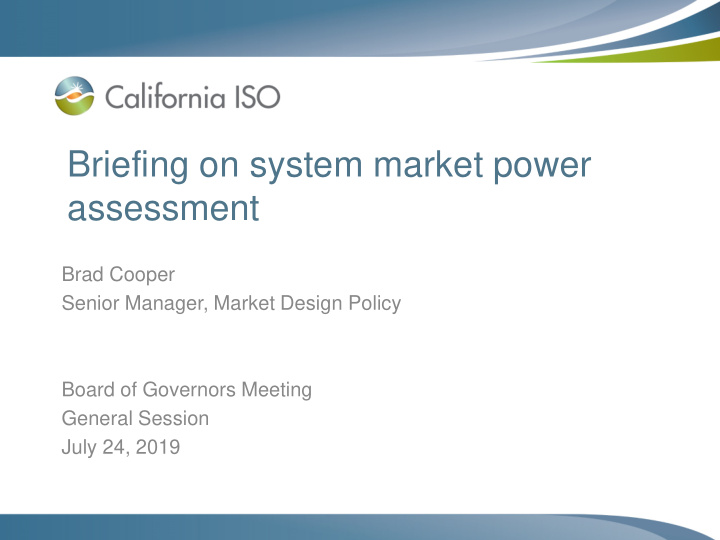



Briefing on system market power assessment Brad Cooper Senior Manager, Market Design Policy Board of Governors Meeting General Session July 24, 2019
Background • The ISO balancing authority area has in the past been assumed to be competitive at a system-level • Management committed to analyzing system-level market competiveness and addressing identified issues after DMM raised concerns in its 2017 annual report • Management recently published analysis results and has begun discussing the appropriate next steps with stakeholders and the Market Surveillance Committee Page 2
ISO’s analysis shows a relatively small number of hours that the ISO balancing area is not competitive at the system level. • Analysis uses “residual supply index” test to evaluate competiveness – Evaluates whether load can be met without the three largest suppliers • The ISO balancing area failed the test at the system level in about 2% of hours in 2018 • These failures generally occur during the net load peak hours when supply is tight • Department of Monitoring metrics show increased price- cost markup in these same peak hours Page 3
Residual supply index test failures mostly occur in the net load peak hours as solar output decreases. Number of Hours Failed Hour of the Day Page 4
High ISO market prices typically occur when supply is tight. Price ($/MWh) Reserve Margin (Supply/Demand) Page 5
High day-ahead market prices occur when natural gas prices are high. DMM Annual Report on Market Issues & Performance, 2018 Page 6
A number of measures could address increased price- cost markup during times of tight supply. • Load-serving entity forward energy contracting – Hedges load, reduces incentives for supply to bid high • Bilateral procurement of additional resources to increase supply during net load peak – Additional energy storage could add supply during net load peak as solar output decreases • Enhanced ISO market scarcity pricing provisions • System-level market power mitigation in ISO market – Would address increased price-cost markups but could reduce import supply – Difficult to estimate costs of import supply Page 7
Next steps • Continue discussions on the appropriate response with stakeholders and Market Surveillance Committee – July 15 stakeholder working group meeting – August 19 Market Surveillance Committee meeting • Plan to brief the Board of Governors on determination of appropriate measures to address system market power concerns – Market Surveillance Committee will provide a written opinion on the appropriate response – Tentatively planned for November Page 8
Recommend
More recommend